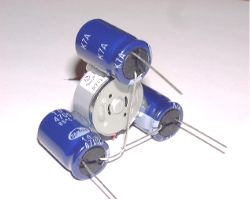How to Build A BEAM Trimet

This article details how to build a solar powered BEAM robot, the Trimet.
Tools and equipment required:
- Soldering iron (about 18W with a fine bit) and solder - Safety glasses (wear them at all times) - Long nose pliers - Side cutters - Wire strippers (optional) - Hot glue gun and glue sticks (or an epoxy) - 3 large capacitors (e.g 4700 µf) - 1 efficient motor (e.g. portable CD player, Walkman, etc. motor) - FLED Solar Engine

1. Attach the three capacitors to the motor body using a hot glue gun (you can use epoxy-resin but it's easier with hot glue). Apply the glue to the lighter colored stripe on the capacitor body (this stripe identifies the negative lead). Align the capacitors vertically so that the bottom of each capacitor is approximately 4 mm below the bottom face of the motor.

2. Bend the three negative leads together and solder them as shown in the photograph.

3. Construct a FLED solarengine.
4. With the two transistors resting on the tops of the front two capacitors solder the emitter leg of the 3904 to a negative capacitor lead and the emitter leg of the 3906 to a positive capacitor lead (the 3906 is a PNP transistor).
5. Now solder the black (negative) motor lead to the protruding collector leg of the 3904 transistor (to which the resistor is attached) and the red (positive) motor lead to any one of the positive capacitor leads. Congratulations you're almost there !
6. From the two brass coated paper clips supplied construct a ring with a diameter of approximately 85mm - 90mm. Bend the clips with a pair of long nose pliers (wear safety glasses when you're doing this) and also trim to length with the pliers. Solder together the ends of the wire to form the ring.
7. Attach the ring to your Trimet using the positive leads of the three capacitors. Form a hook with the leads to secure the ring prior to soldering. You will probably need to extend the lead of the front right capacitor (see photograph) - use a piece of the brass coated paper clip that you trimmed off in the previous operation. We've got the traction, the fuel tanks, the engine and the sensor now all we need to add is the fuel converter and the drive wheel.
8. Solder two short (30mm long) pieces of the PVC coated multi-strand wire to the solarcell. Solder the red lead to the positive pad and the black lead to the negative. Take care when doing this - do not over heat the tinned pads on the solarcell. These are easy to solder because there is already a generous amount of solder on the pads. Solder the red lead so that it runs parallel to the 'Panasonic' text on the cell and the black lead so that it runs perpendicular to the 'Panasonic' text as shown in the photograph.
9. Solder the leads attached to the solarcell to the capacitor leads - red lead to a positive capacitor lead (any of those attached to the sensor ring) and black lead to a negative capacitor lead (the lead nearest the light stripe on the capacitor). Secure the solarcell to the body using a little hot glue (or a little epoxy-resin). Do not allow the solarcell pads to touch any of the component leads.
10. Cut a short section of hot glue stick (about 6mm - 7mm long) with a pair of scissors or a craft knife (take care!), melt a small hole in one end of the piece of glue stick (not in your finger - it hurts!) and push the 'wheel' onto the motor shaft. Position the 'wheel' so that there is between 5mm - 7mm from the bottom of the 'wheel' to the bottom of the capacitors. This will allow the Trimet to lean over onto two of the capacitors at the appropriate angle. You can adjust this dimension later to produce the optimum performance. Ideally you want the Trimet to skid along in a straight line - have you seen the James Bond film where he drives a car on two wheels down a narrow alley - like that! Oh and by the way you've finished. Place your Trimet (wheel down) on a smooth surface (plastic table top, piece of polished timber, etc) in sunlight (doesn't have to be full sun) and wait for her / him to trigger (every 3 - 5 seconds in full sun). In the absence of daylight you can also use a halogen lamp or an ordinary bulb (although it will take longer to trigger). Editors Note: TotalRobots is a British based robotics company. You can visit their website and order some of their products off their website. The above tutorial is Copyright © Total Robots. Spencer Scott has written another excellent article about building a BEAM Symet. You can read his article and get some other ideas.
Thanks for helping to keep our community civil!
This post is an advertisement, or vandalism. It is not useful or relevant to the current topic.
You flagged this as spam. Undo flag.Flag Post









